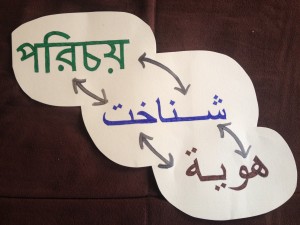Navigating Language and Translation
In this project, the word identity was taken and inserted into Google Translate – it was inputted and translated first to Arabic, then to Urdu, and lastly to Bengali. This mechanism of online translation recapitulates many of the issues with translation that were discussed. Google translate also in a way embodies what Tony Stewart calls the “search for equivalence” in meaning from one word to the next (Stewart, 2001). In his explanation of the spread of Islam in the Bengal, this search for equivalence was used to translate ideas in Islam using the vernacular and preexisting notions that existed in the “original conceptual structure” of the language instead of adhering to “strict and unambiguous use of Islamic vocabulary” (Stewart, 2001).
It also references the perceived hierarchy of languages and what languages are perceived to be more Muslim than others. At the bottom is Arabic read left to right. Urdu, a Persianized alphabet of the language of Hind sits in the middle as language straddling two identities: that of the ethnic South Asian, and the connection to the Turko-Persian/Arab world through its stylized alphabet. At the top sits Bengali with its Sanksrit-rooted alphabet and language. Speakers of all three languages practice Islam, yet historically the Arabic and Persian rooted forms have called for dominance above others. A key example of this idea was the significance of language as a flashpoint in East Pakistan which precipitated to the Bangladesh Liberation War.
